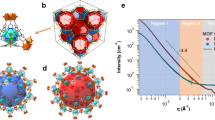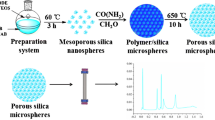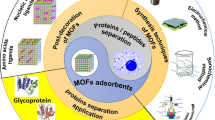Abstract
Covalent organic frameworks (COFs) are prominent porous materials for molecules separation due to their desirable structures. However, very few COFs are reported for the separation of macromolecules such as low molecular-weight (MW) proteins. Here, two stable mesoporous COFs (Azo-COF and Tp-COF) with highly crystallized frameworks are synthesized, and their pore sizes are slightly-regulated via elaborate selection of pyrene knots and amino linkages. Benefiting from the pore size difference less than 4 Å, the tandem utilization of these two COFs exhibits efficiently size-selective separation ability towards low MW proteins cytochrome c and myoglobin with small MW difference of 2 kDa, in which protein adsorption possibilities are verified by computational calculations together with confocal laser scanning microscopy (CLSM). Furthermore, a simple COF-based separation device is designed and prepared to achieve effective and low-consumption proteins separation. This work has offered an optimized synthetic strategy for fine-tuned mesoporous COFs and expanded their applications on macromolecules separation.

Similar content being viewed by others
References
Egas, D. A.; Wirth, M. J. Fundamentals of protein separations: 50 years of nanotechnology, and growing. Annu. Rev. Anal. Chem. 2008, 1, 833–855.
Li, J.; Liao, X. P.; Zhang, Q. X.; Shi, B. Adsorption and separation of proteins by collagen fiber adsorbent. J. Chromatogr. B 2013, 928, 131–138.
Tirumalai, R. S.; Chan, K. C.; Prieto, D. A.; Issaq, H. J.; Conrads, T. P.; Veenstra, T. D. Characterization of the low molecular weight human serum proteome. Mol. Cell. Proteomics 2003, 2, 1096–1103.
Sun, Q.; Pan, Y. X.; Wang, X. L.; Li, H.; Farmakes, J.; Aguila, B.; Yang, Z. Y.; Ma, S. Q. Mapping out the degree of freedom of hosted enzymes in confined spatial environments. Chem 2019, 5, 3184–3195.
Sun, Q.; Fu, C. W.; Aguila, B.; Perman, J.; Wang, S.; Huang, H. Y.; Xiao, F. S.; Ma, S. Q. Pore environment control and enhanced performance of enzymes infiltrated in covalent organic frameworks. J. Am. Chem. Soc. 2018, 140, 984–992.
Li, M. M.; Qiao, S.; Zheng, Y. L.; Andaloussi, Y. H.; Li, X.; Zhang, Z. J.; Li, A.; Cheng, P.; Ma, S. Q.; Chen, Y. Fabricating covalent organic framework capsules with commodious microenvironment for enzymes. J. Am. Chem. Soc. 2020, 142, 6675–6681.
Qiao, S.; Duan, W. J.; Yu, J. Y.; Zheng, Y. L.; Yan, D.; Jin, F. Z.; Zhang, S. N.; Zhang, Z. J.; Chen, H. X.; Huang, H. et al. Fabrication of biomolecule-covalent-organic-framework composites as responsive platforms for smart regulation of fermentation application. ACS Appl. Mater. Interfaces 2021, 13, 32058–32066.
Zhang, S. N.; Zheng, Y. L.; An, H. D.; Aguila, B.; Yang, C. X.; Dong, Y. Y.; Xie, W.; Cheng, P.; Zhang, Z. J.; Chen, Y. et al. Covalent organic frameworks with chirality enriched by biomolecules for efficient chiral separation. Angew. Chem., Int. Ed. 2018, 57, 16754–16759.
Sun, Q.; Aguila, B.; Lan, P. C.; Ma, S. Q. Tuning pore heterogeneity in covalent organic frameworks for enhanced enzyme accessibility and resistance against denaturants. Adv. Mater. 2019, 31, 1900008.
Structural Genomics Consortium; Architecture et Fonction des Macromolécules Biologiques; Berkeley Structural Genomics Center; China Structural Genomics Consortium; Integrated Center for Structure and Function Innovation; Israel Structural Proteomics Center; Joint Center for Structural Genomics; Midwest Center for Structural Genomics; New York Structural GenomiX Research Center for Structural Genomics; Northeast Structural Genomics Consortium et al. Addendum: Protein production and purification. Nat. Methods 2008, 5, 369.
Zheng, K.; Chen, Y.; Wang, X. H.; Zhao, X. T.; Qian, W. W.; Xu, Y. S. Selective protein separation based on charge anisotropy by spherical polyelectrolyte brushes. Langmuir 2020, 36, 10528–10536.
Côté, A. P.; Benin, A. I.; Ockwig, N. W.; O’Keeffe, M.; Matzger, A. J.; Yaghi, O. M. Porous, crystalline, covalent organic frameworks. Science 2005, 310, 1166–1170.
Huang, N.; Wang, P.; Jiang, D. L. Covalent organic frameworks: A materials platform for structural and functional designs. Nat. Rev. Mater. 2016, 1, 16068.
Li, X.; Yadav, P.; Loh, K. P. Function-oriented synthesis of two-dimensional (2D) covalent organic frameworks—From 3D solids to 2D sheets. Chem. Soc. Rev. 2020, 49, 4835–4866.
Liang, R. R.; Jiang, S. Y.; A, R. H.; Zhao, X. Two-dimensional covalent organic frameworks with hierarchical porosity. Chem. Soc. Rev. 2020, 49, 3920–3951.
Li, Y. S.; Chen, W. B.; Xing, G. L.; Jiang, D. L.; Chen, L. New synthetic strategies toward covalent organic frameworks. Chem. Soc. Rev. 2020, 49, 2852–2868.
Yuan, F. Y.; Tan, J.; Guo, J. Assemblies of covalent organic framework microcrystals: Multiple-dimensional manipulation for enhanced applications. Sci. China Chem. 2018, 61, 143–152.
Song, Y. P.; Sun, Q.; Aguila, B.; Ma, S. Q. Opportunities of covalent organic frameworks for advanced applications. Adv. Sci. 2019, 6, 1801410.
Yusran, Y.; Guan, X. Y.; Li, H.; Fang, Q. R.; Qiu, S. L. Postsynthetic functionalization of covalent organic frameworks. Natl. Sci. Rev. 2020, 7, 170–190.
Chen, Q. D.; Tang, J. J.; Fang, Q. R. Highly stable fluorine containing hierarchical porous covalent organic framework. Chem. J. Chin. Univ. 2018, 39, 2357–2362.
Zeng, Y. F.; Zou, R. Q.; Zhao, Y. L. Covalent organic frameworks for CO2 capture. Adv. Mater. 2016, 28, 2855–2873.
Rieth, A. J.; Dincă, M. Programming framework materials for ammonia capture. ACS Cent. Sci. 2018, 4, 666–667.
Yang, Y. J.; Faheem, M.; Wang, L. L.; Meng, Q. H.; Sha, H. Y.; Yang, N.; Yuan, Y.; Zhu, G. S. Surface pore engineering of covalent organic frameworks for ammonia capture through synergistic multivariate and open metal site approaches. ACS Cent. Sci. 2018, 4, 748–754.
Jiang, L. C.; Tian, Y. Y.; Sun, T.; Zhu, Y. L.; Ren, H.; Zou, X. Q.; Ma, Y. H.; Meihaus, K. R.; Long, J. R.; Zhu, G. A crystalline polyimide porous organic framework for selective adsorption of acetylene over ethylene. J. Am. Chem. Soc. 2018, 140, 15724–15730.
Peng, Y. W.; Xu, G. D.; Hu, Z. G.; Cheng, Y. D.; Chi, C. L.; Yuan, D. Q.; Cheng, H. S.; Zhao, D. Mechanoassisted synthesis of sulfonated covalent organic frameworks with high intrinsic proton conductivity. ACS Appl. Mater. Interfaces 2016, 8, 18505–18512.
Xu, H.; Tao, S. S.; Jiang, D. L. Proton conduction in crystalline and porous covalent organic frameworks. Nat. Mater. 2016, 15, 722–726.
Yang, Y.; He, X. Y.; Zhang, P. H.; Andaloussi, Y. H.; Zhang, H. L.; Jiang, Z. Y.; Chen, Y.; Ma, S. Q.; Cheng, P.; Zhang, Z. J. Combined intrinsic and extrinsic proton conduction in robust covalent organic frameworks for hydrogen fuel cell applications. Angew. Chem., Int. Ed. 2020, 59, 3678–3684.
Wang, X. Y.; Chen, L. J.; Chong, S. Y.; Little, M. A.; Wu, Y. Z.; Zhu, W. H.; Clowes, R.; Yan, Y.; Zwijnenburg, M. A.; Sprick, R. S. et al. Sulfone-containing covalent organic frameworks for photocatalytic hydrogen evolution from water. Nat. Chem. 2018, 10, 1180–1189.
Chen, R. F.; Shi, J. L.; Ma, Y.; Lin, G. Q.; Lang, X. J.; Wang, C. Designed synthesis of a 2D porphyrin-based sp2 carbon-conjugated covalent organic framework for heterogeneous photocatalysis. Angew. Chem., Int. Ed. 2019, 58, 6430–6434.
Wang, L. K.; Zhou, J. J.; Lan, Y. B.; Ding, S. Y.; Yu, W.; Wang, W. Divergent synthesis of chiral covalent organic frameworks. Angew. Chem., Int. Ed. 2019, 58, 9443–9447.
Feng, X. F.; Gao, Z.; Xiao, L. H.; Lai, Z. Q.; Luo, F. A Ni/Fe complex incorporated into a covalent organic framework as a singlesite heterogeneous catalyst for efficient oxygen evolution reaction. Inorg. Chem. Front. 2020, 7, 3925–3931.
Kaczmarek, A. M.; Jena, H. S.; Krishnaraj, C.; Rijckaert, H.; Veerapandian, S. K. P.; Meijerink, A. van der Voort, P. Luminescent ratiometric thermometers based on a 4F-3D grafted covalent organic framework to locally measure temperature gradients during catalytic reactions. Angew. Chem., Int. Ed. 2021, 60, 3727–3736.
Lv, J. Q.; Tan, Y. X.; Xie, J. F.; Yang, R.; Yu, M. X.; Sun, S. S.; Li, M. D.; Yuan, D. Q.; Wang, Y. B. Direct solar-to-electrochemical energy storage in a functionalized covalent organic framework. Angew. Chem., Int. Ed. 2018, 57, 12716–12720.
Guo, Z. B.; Zhang, Y. Y.; Dong, Y.; Li, J.; Li, S. W.; Shao, P. P.; Feng, X.; Wang, B. Fast ion transport pathway provided by polyethylene glycol confined in covalent organic frameworks. J. Am. Chem. Soc. 2019, 141, 1923–1927.
Bisbey, R. P.; Dichtel, W. R. Covalent organic frameworks as a platform for multidimensional polymerization. ACS Cent. Sci. 2017, 3, 533–543.
Yaghi, O. M.; O’Keeffe, M.; Ockwig, N. W.; Chae, H. K.; Eddaoudi, M.; Kim, J. Reticular synthesis and the design of new materials. Nature 2003, 423, 705–714.
Zou, X. Q.; Ren, H.; Zhu, G. S. Topology-directed design of porous organic frameworks and their advanced applications. Chem. Commun. 2013, 49, 3925–3936.
Fang, Q. R.; Zhuang, Z. B.; Gu, S.; Kaspar, R. B.; Zheng, J.; Wang, J. H.; Qiu, S. L.; Yan, Y. S. Designed synthesis of large-pore crystalline polyimide covalent organic frameworks. Nat. Commun. 2014, 5, 4503.
Rabbani, M. G.; Sekizkardes, A. K.; Kahveci, Z.; Reich, T. E.; Ding, R. S.; El-Kaderi, H. M. A 2D mesoporous imine-linked covalent organic framework for high pressure gas storage applications. Chem.—Eur. J. 2013, 19, 3324–3328.
Jin, E. Q.; Asada, M.; Xu, Q.; Dalapati, S.; Addicoat, M. A.; Brady, M. A.; Xu, H.; Nakamura, T.; Heine, T.; Chen, Q. H. et al. Two-dimensional sp2 carbon-conjugated covalent organic frameworks. Science 2017, 357, 673–676.
Sun, Z. T.; Liu, Q.; Qu, G.; Feng, Y.; Reetz, M. T. Utility of b-factors in protein science: Interpreting rigidity, flexibility, and internal motion and engineering thermostability. Chem. Rev. 2019, 119, 1626–1665.
Zhao, D. Y.; Tian, Y. Y.; Jing, X. F.; Lu, Y.; Zhu, G. S. PAF1@cellulose nanofibril composite aerogel for highly-efficient removal of bisphenol A. J. Mater. Chem. 2019, 7, 157–164.
Yan, Y. H.; Wu, S. M.; Yan, Y. L.; Tang, X. H.; Cai, S. L.; Zheng, S. R.; Zhang, W. G.; Gu, F. L. Sulfonic acid-functionalized spherical covalent organic framework with ultrahigh capacity for the removal of cationic dyes. Chem. J. Chin. Univ. 2021, 42, 956–964.
He, H. M.; Han, H. B.; Shi, H.; Tian, Y. Y.; Sun, F. X.; Song, Y.; Li, Q. S.; Zhu, G. S. Construction of thermophilic lipase-embedded metal-organic frameworks via biomimetic mineralization: A biocatalyst for ester hydrolysis and kinetic resolution. ACS Appl. Mater. Interfaces 2016, 8, 24517–24524.
Acknowledgements
The authors are grateful for the financial support from the Fundamental Research Funds for the Central Universities (No. 2412019FZ008), the National Natural Science Foundation of China (Nos. 21503038 and 22074014), and the “111” project (No. B18012).
Author information
Authors and Affiliations
Corresponding authors
Electronic supplementary material
Rights and permissions
About this article
Cite this article
Wang, T., Azhar, I., Yang, Y. et al. Fine-tuned mesoporous covalent organic frameworks for highly efficient low molecular-weight proteins separation. Nano Res. 15, 4569–4574 (2022). https://doi.org/10.1007/s12274-022-4078-z
Received:
Revised:
Accepted:
Published:
Issue Date:
DOI: https://doi.org/10.1007/s12274-022-4078-z




